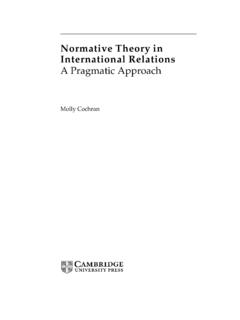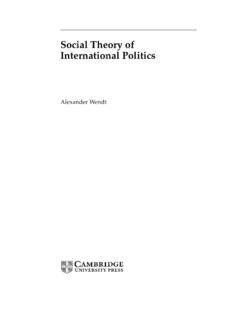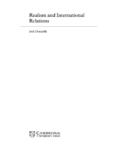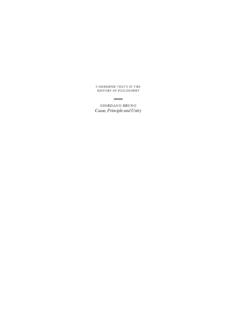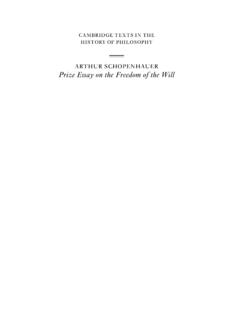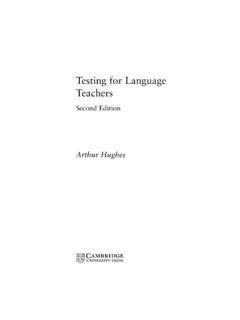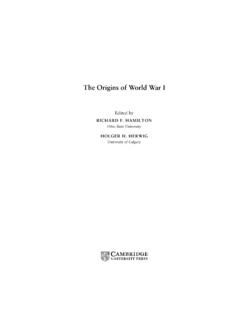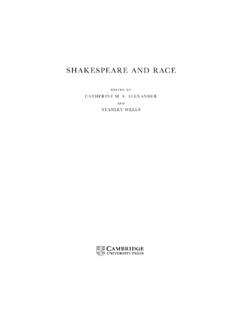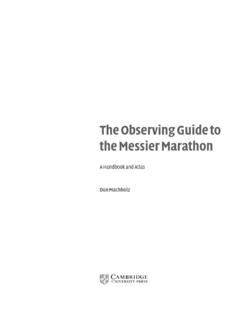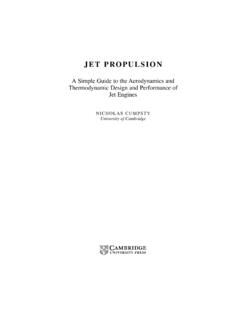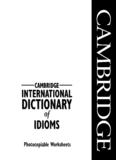Transcription of P1 T Cambridge Grammar of the English Language
1 P1: FCH. CU097-FM February 7, 2002 22:31. The Cambridge Grammar of the English Language Rodney Huddleston Geoffrey K. Pullum in collaboration with Laurie Bauer Betty Birner Ted Briscoe Peter Collins David Denison David Lee Anita Mittwoch Geoffrey Nunberg Frank Palmer John Payne Peter Peterson Lesley Stirling Gregory Ward P1: FCH. CU097-FM February 7, 2002 22:31. published by the press syndicate of the university of Cambridge The Pitt Building, Trumpington Street, Cambridge , United Kingdom Cambridge university press The Edinburgh Building, Cambridge cb2 2ru, UK. 40 West 20th Street, New York, ny 10011-4211, USA. 477 Williamstown Road, Port Melbourne, vic 3207, Australia 13, 28014 Madrid, Spain Ruiz de Alarcon Dock House, The Waterfront, Cape Town, 8001, South Africa.
2 C Cambridge University Press 2002. This book is in copyright. Subject to statutory exception and to the provisions of relevant collective licensing agreements, no reproduction of any part may take place without the written permission of Cambridge University Press. First published 2002. Printed in the United Kingdom by William Clowes Ltd, Beccles, Suffolk Typefaces Adobe Minion 10/13 pt & ffTheSans System LATEX 2 [tb]. A catalogue record for this book is available from the British Library. Library of Congress cataloguing in publication data Huddleston, Rodney D. The Cambridge Grammar of the English Language /. Rodney Huddleston, Geoffrey K. Pullum p. cm. Includes bibliographical references and index. isbn 0 521 43146 8 (hardback). 1. English Language Grammar .
3 I. Pullum, Geoffrey K. ii. Title. 2002 425 dc21 2001025630. isbn 0 521 43146 8 (hardback). P1: FCH. CU097-FM February 7, 2002 22:31. v Contents List of contributors vi Notational conventions x Tree diagrams xiii Preface xv 1 Preliminaries 1. Geoffrey K. Pullum and Rodney Huddleston 2 Syntactic overview 43. Rodney Huddleston 3 The verb 71. Rodney Huddleston 4 The clause: complements 213. Rodney Huddleston 5 Nouns and noun phrases 323. John Payne and Rodney Huddleston 6 Adjectives and adverbs 525. Geoffrey K. Pullum and Rodney Huddleston 7 Prepositions and preposition phrases 597. Geoffrey K. Pullum and Rodney Huddleston 8 The clause: adjuncts 663. Anita Mittwoch, Rodney Huddleston, and Peter Collins 9 Negation 785. Geoffrey K. Pullum and Rodney Huddleston 10 Clause type and illocutionary force 851.
4 Rodney Huddleston 11 Content clauses and reported speech 947. Rodney Huddleston 12 Relative constructions and unbounded dependencies 1031. Rodney Huddleston, Geoffrey K. Pullum, and Peter Peterson 13 Comparative constructions 1097. Rodney Huddleston 14 Non-finite and verbless clauses 1171. Rodney Huddleston 15 Coordination and supplementation 1273. Rodney Huddleston, John Payne, and Peter Peterson 16 Information packaging 1363. Gregory Ward, Betty Birner, and Rodney Huddleston 17 Deixis and anaphora 1449. Lesley Stirling and Rodney Huddleston 18 Inflectional morphology and related matters 1565. Frank Palmer, Rodney Huddleston, and Geoffrey K. Pullum 19 Lexical word-formation 1621. Laurie Bauer and Rodney Huddleston 20 Punctuation 1723. Geoffrey Nunberg, Ted Briscoe, and Rodney Huddleston Further reading 1765.
5 Index 1779. Lexical index 1780. Conceptual index 1813. P1: HEF. CU097-01 February 7, 2002 21:2. 1. Preliminaries Geoffrey K. Pullum Rodney Huddleston 1 The aim of this book 2. 2 Prescriptivism, tradition, and the justification of grammars 5. Prescriptive and descriptive approaches: goals and coverage 5. Disagreement between descriptivist and prescriptivist work 6. 3 Speech and writing 11. The representation of English pronunciation 13. Rhotic and non-rhotic accents 13. An accent-neutral phonological representation 14. Pronunciation and spelling 17. 4 Theoretical framework 18. Description and theory 18. Basic concepts in syntax 20. Constituent structure 20. Syntactic categories 21. Grammatical constructions and functions 23. Morphology, inflectional and lexical 26.
6 Defining grammatical concepts 28. 5 Semantics, pragmatics, and meaning relations 33. Truth conditions and entailment 34. Non-truth-conditional aspects of sentence meaning 36. Pragmatics and conversational implicatures 37. Pragmatic presupposition 40. 1. P1: HEF. CU097-01 February 7, 2002 21:2. 2. 1 The aim of this book This book is a description of the Grammar of modern Standard English , providing a detailed account of the principles governing the construction of English words, phrases, clauses, and sentences. To be more specific, we give a synchronic, descriptive Grammar of general-purpose, present-day, international Standard English . Synchronic versus diachronic description A synchronic description of a Language is a snapshot of it at one point in time, the opposite of a diachronic or historical account.
7 English has a rich history going back over a millennium, but it is not the aim of this book to detail it. We include only a few notes on historical points of interest that will assist the reader to understand the present state of the Language . Of course, at any given moment English speakers with birthdates spread over about a century are alive, so the idea of English as it is on one particular day is a fiction: the English used today was learned by some speakers at the end of the twentieth cen- tury and by others near the beginning. But our practice will be to illustrate relevant points mainly with examples of use of the Language taken from prose produced since the mid twentieth century. Examples from earlier periods are used only when particularly apposite quotations are available for a point on which the Language has not subse- quently changed.
8 Wherever grammatical change has clearly occurred, our aim will be not to describe the evolutionary process but rather to describe the current state of the Language . Description versus prescription Our aim is to describe and not prescribe: we outline and illustrate the principles that govern the construction of words and sentences in the present-day Language without recommending or condemning particular usage choices. Although this book may be (and we certainly hope it will be) of use in helping the user decide how to phrase things, it is not designed as a style guide or a usage manual. We report that sentences of some types are now widely found and used, but we will not advise you to use them. We state that sentences of some types are seldom encountered, or that usage manuals or Language columnists or Language teachers recommend against them, or that some form of words is normally found only in informal style or, conversely, is limited to rather formal style, but we will not tell you that you should avoid them or otherwise make recommendations about how you should speak or write.
9 Rather, this book offers a description of the context common to all such decisions: the linguistic system itself. P1: HEF. CU097-01 February 7, 2002 21:2. 1 The aim of this book 3. General-purpose versus special-purpose We exclude from consideration what we refer to as special-purpose varieties of the Language . Newspaper headlines, road signs, notices, and the like have their own special styles of abbreviation (Man bites dog, arrested; EXIT ONLY THIS LANE), and we do not provide a full treatment of the possibilities. Likewise, we do not provide a description of any special notations (chemical formulae, telephone numbers, email addresses) or of the special Language found in poetry, heraldic descriptions, scientific works, chemical compound naming, computer jargon, mathematical proofs, etc.
10 To some small extent there may be idiosyncratic grammatical patterns found in such areas, but we generally set them aside, avoiding complicated digressions about usages found within only a very narrow range of discourse. Present-day English versus earlier stages Modern English is generally defined by historians of English to be the English used from 1776 onwards. The recent part of the latter period (say, since the Second World War). can be called Present-day English . Linguistic changes have occurred in the Grammar of English during the Modern English period, and even during the last half-century. Our central aim is to describe Present-day English in its standard form. This means, for example, that we treat the pronoun system as not containing a contrast between familiar and respectful 2nd person pronouns: the contrast between thou and you has been lost, and we do not mention thou in this Grammar .
